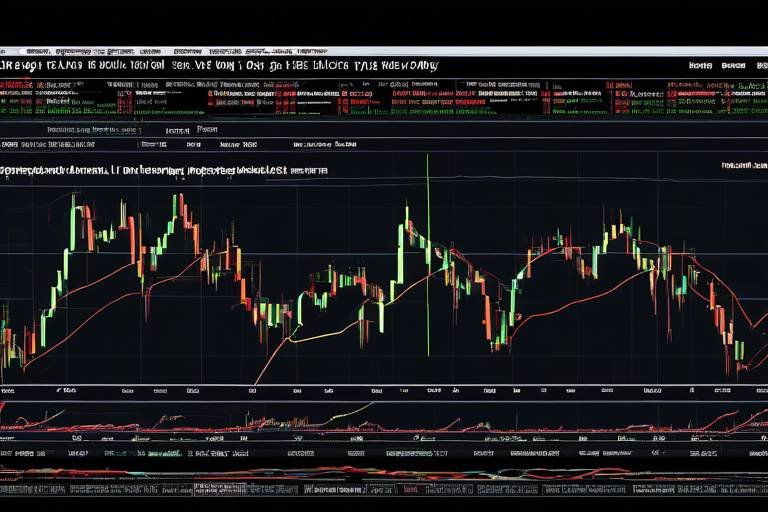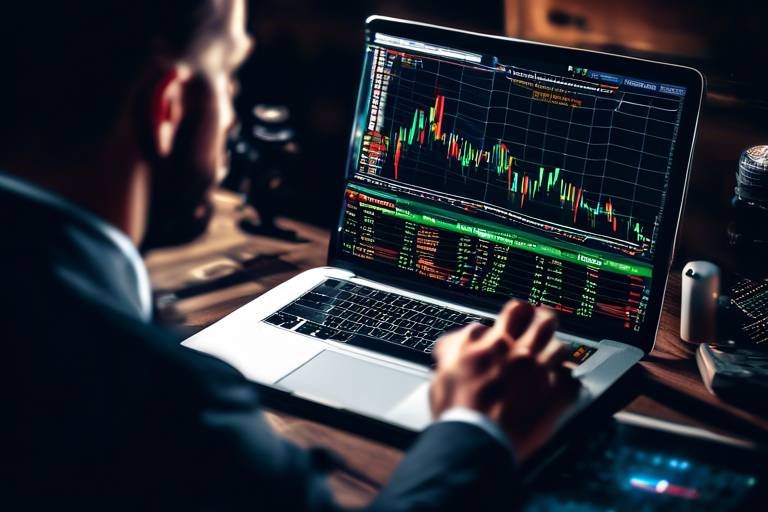The Best Practices for Trading Crypto on Exchanges
In the fast-paced world of cryptocurrency trading, having a solid foundation of best practices can be the difference between success and failure. As digital currencies continue to gain traction, understanding how to navigate exchanges effectively becomes crucial for both novice and experienced traders alike. This article delves into essential practices that can enhance your trading outcomes, including risk management, market analysis, and security measures. Whether you’re looking to make a quick profit or invest for the long haul, these insights will help you maneuver through the complexities of crypto trading with confidence.
Before diving into the world of trading, it’s essential to grasp the different types of cryptocurrency exchanges available. There are primarily two categories: centralized exchanges (CEX) and decentralized exchanges (DEX). Centralized exchanges are platforms like Binance and Coinbase, where a third party facilitates transactions. These platforms often offer user-friendly interfaces and a wide variety of cryptocurrencies. On the other hand, decentralized exchanges like Uniswap operate without a central authority, allowing users to trade directly with one another. While DEXs provide greater privacy and control over your assets, they may lack the same level of liquidity and user support as their centralized counterparts.
Selecting the right exchange is vital for your trading success. It’s not just about picking the most popular platform; you should consider multiple factors that align with your trading goals. Here are some key aspects to evaluate:
- Fees: Different exchanges have varying fee structures, including trading fees, withdrawal fees, and deposit fees. Understanding these can significantly affect your profitability.
- Security: Look for exchanges that prioritize user security, offering features like two-factor authentication and cold storage for assets.
- Available Cryptocurrencies: Ensure the exchange supports the cryptocurrencies you intend to trade.
Security should be at the forefront of your mind when trading cryptocurrencies. With the rise of hacking incidents and scams, it’s crucial to choose an exchange that implements robust security measures. Look for features such as:
Implementing two-factor authentication (2FA) adds an extra layer of security to your account. This means that even if someone gets hold of your password, they still need a second form of verification to access your account, significantly reducing the risk of unauthorized access.
Another effective security measure is the use of withdrawal whitelists. This feature allows you to designate specific addresses to which you can withdraw funds. If someone attempts to withdraw to an unapproved address, the transaction will be blocked, enhancing your account's overall security.
Trading fees can eat into your profits if you're not careful. It’s essential to understand the various types of fees associated with trading on exchanges. There are typically three main types:
- Maker Fees: Charged when you add liquidity to the order book.
- Taker Fees: Charged when you take liquidity from the order book.
- Withdrawal Fees: Charged when you withdraw your funds from the exchange.
By being aware of these fees, you can strategize your trades to minimize costs and maximize returns.
A solid trading strategy is essential for success in the crypto market. Without a plan, you might find yourself making impulsive decisions based on emotions rather than data. There are various trading strategies to consider:
- Day Trading: Involves making multiple trades within a single day to capitalize on short-term price movements.
- Swing Trading: Focuses on capturing price swings over a few days or weeks.
- Long-Term Investing: Involves holding onto assets for an extended period, betting on their long-term value appreciation.
Technical analysis is a critical skill for any trader. It involves analyzing price charts and patterns to make informed trading decisions. Familiarizing yourself with fundamental concepts such as support and resistance levels, moving averages, and volume indicators can significantly enhance your trading strategies.
While technical analysis focuses on price movements, fundamental analysis evaluates the underlying value of cryptocurrencies. This includes assessing market trends, news, and the fundamentals of the projects behind the coins. By combining both analytical approaches, you can make more informed trading decisions.
Effective risk management is vital for long-term trading success. It's not just about how much you can gain; it's also about how much you can afford to lose. Techniques like setting stop-loss orders and determining proper position sizing can help you manage your risks effectively.
Diversification is a key strategy to mitigate risks. By spreading your investments across different assets, you can protect yourself from the volatility of any single cryptocurrency. Consider building a well-balanced crypto portfolio that includes a mix of established coins and promising altcoins.
Setting achievable trading goals can greatly enhance your discipline and focus. It’s essential to have realistic expectations about your trading performance. Regularly evaluating your progress against these goals can help you stay on track and adjust your strategies as necessary.
Q: What is the best cryptocurrency exchange for beginners?
A: It often depends on personal preference, but exchanges like Coinbase and Binance are user-friendly and offer a wide range of educational resources for beginners.
Q: How can I ensure my cryptocurrencies are safe?
A: Use exchanges that offer robust security features, enable two-factor authentication, and consider storing your assets in a hardware wallet for added security.
Q: What are the risks of trading cryptocurrencies?
A: The risks include market volatility, potential loss of funds due to hacking, and emotional decision-making. Implementing risk management strategies can help mitigate these risks.

Understanding Cryptocurrency Exchanges
This article explores essential practices for successful cryptocurrency trading on exchanges, including risk management, market analysis, and security measures to enhance trading outcomes.
When diving into the world of cryptocurrency, the first thing you need to grasp is the concept of cryptocurrency exchanges. Think of these platforms as the bustling marketplaces of the digital currency world, where buyers and sellers come together to trade various cryptocurrencies. But not all exchanges are created equal! There are two main types: centralized exchanges (CEX) and decentralized exchanges (DEX).
Centralized exchanges are like your traditional stock exchanges. They act as intermediaries between buyers and sellers, making the trading process smoother and more user-friendly. Platforms like Binance and Coinbase fall into this category. They typically offer a wide range of features, including advanced trading tools, customer support, and high liquidity. However, they also come with a few caveats, such as the need to trust a third party with your funds and the potential for hacking incidents.
On the flip side, we have decentralized exchanges. These are the wild west of cryptocurrency trading! They operate without a central authority, allowing users to trade directly with one another. This means you have more control over your funds, but it can also lead to a steeper learning curve. DEXs like Uniswap and SushiSwap are popular choices, especially among those who value privacy and autonomy. However, they might not offer the same level of liquidity or customer support as their centralized counterparts.
Now, you might be wondering how these exchanges affect your trading strategies and overall user experience. Well, it all boils down to a few key features:
- Liquidity: This refers to how easily you can buy or sell a cryptocurrency without affecting its price. Centralized exchanges usually have higher liquidity due to their larger user base.
- User Interface: A friendly and intuitive interface can make your trading experience far more enjoyable. Centralized exchanges often invest in user experience, while DEXs may focus more on functionality.
- Fees: Different exchanges have varying fee structures. Centralized exchanges often charge trading fees, while DEXs may have different mechanisms, such as liquidity provider fees.
To sum it up, understanding the differences between centralized and decentralized exchanges is crucial for any aspiring crypto trader. Your choice of exchange will significantly influence your trading experience, so take the time to explore your options. Remember, the right exchange can be the difference between a smooth trading journey and a rocky road filled with obstacles!
Q: What is a cryptocurrency exchange?
A cryptocurrency exchange is a platform that allows you to buy, sell, or trade cryptocurrencies. They can be centralized or decentralized, each offering unique features and benefits.
Q: How do I choose the right exchange?
Consider factors like security, fees, available cryptocurrencies, and user experience when selecting an exchange. A good exchange should align with your trading goals and preferences.
Q: Are decentralized exchanges safe?
While DEXs offer greater control over your funds and increased privacy, they also come with risks such as lower liquidity and potential smart contract vulnerabilities. Always do your research!

Choosing the Right Exchange
When it comes to trading cryptocurrencies, choosing the right exchange is like picking the right vehicle for a long journey. You wouldn’t want to drive a clunker across the country, right? The same principle applies here. There are several factors to consider that can significantly impact your trading experience and success. First and foremost, you need to evaluate the fees associated with the exchange. Each platform has its own fee structure, which can include trading fees, withdrawal fees, and deposit fees. Understanding these costs is crucial because they can eat into your profits faster than you can say “blockchain.”
Next, security should be at the forefront of your mind when selecting an exchange. With the increasing number of cyber attacks and hacks, it’s essential to choose a platform that prioritizes the safety of your assets. Look for exchanges that offer robust security measures such as two-factor authentication (2FA), insurance against theft, and cold storage for funds. After all, you wouldn’t leave your front door wide open while you’re away, would you?
Another critical factor is the variety of cryptocurrencies available for trading. Some exchanges only offer a limited selection, while others provide access to a vast array of altcoins. If you have specific coins in mind that you want to trade, make sure the exchange supports them. It’s like going to a grocery store that only sells apples when you’re craving bananas! To help you visualize, here’s a simple comparison of exchange features:
| Exchange | Fees | Security Features | Available Cryptocurrencies |
|---|---|---|---|
| Exchange A | 0.2% trading fee | 2FA, cold storage | 50+ |
| Exchange B | 0.1% trading fee | Insurance, 2FA | 100+ |
| Exchange C | 0.25% trading fee | Cold storage only | 30+ |
In addition to fees and security, take a moment to consider the user experience of the exchange. A well-designed platform that is easy to navigate can make a world of difference, especially for beginners. Look for features like a user-friendly interface, responsive customer support, and educational resources. Think of it like this: would you rather drive a car with a complicated dashboard or one that’s intuitive and easy to understand?
Finally, don’t forget to check the regulatory compliance of the exchange. Make sure it operates in accordance with the laws of your country and has the necessary licenses to trade. This can help protect you from potential legal issues down the road. After all, trading on an unregulated exchange is akin to sailing a ship without a compass—you might end up lost at sea!
In summary, when choosing the right exchange, keep these factors in mind: fees, security, available cryptocurrencies, user experience, and regulatory compliance. By taking the time to research and evaluate these aspects, you’ll be better equipped to make an informed decision that aligns with your trading goals.
- What should I look for in a cryptocurrency exchange? Focus on fees, security features, available cryptocurrencies, user experience, and regulatory compliance.
- Are all exchanges secure? No, security varies by exchange. Always choose platforms with strong security measures.
- Can I trade any cryptocurrency on any exchange? No, not all exchanges offer the same cryptocurrencies. Check if your desired coins are available.
- How do trading fees affect my profits? Higher fees can significantly reduce your overall profitability, so it’s essential to choose an exchange with competitive rates.

Evaluating Exchange Security
When it comes to trading cryptocurrencies, security should be at the forefront of your mind. Imagine you’ve just invested a significant amount of your hard-earned money into a promising digital asset, only to find out that the exchange you chose has been compromised. The reality is, the crypto world can be a treacherous place if you're not careful. Therefore, understanding how to evaluate the security features of an exchange is crucial for protecting your investments.
To begin with, you want to look for exchanges that have a solid reputation in the industry. This involves checking for reviews and feedback from other users. A platform with a history of security breaches might not be the best choice, no matter how appealing their fees or user interface may seem. But what specific security features should you be on the lookout for? Here are some key aspects:
- Cold Storage: Ensure that the exchange keeps a majority of its funds in cold storage. This means that most of the cryptocurrencies are stored offline, which significantly reduces the risk of hacking.
- Insurance Policies: Some exchanges offer insurance policies for digital assets. This can provide an extra layer of protection in the event of a security breach.
- Regular Security Audits: A reputable exchange will undergo regular security audits to identify and rectify vulnerabilities. Look for platforms that are transparent about their security practices.
Another critical aspect of exchange security is the implementation of Two-Factor Authentication (2FA). This feature adds an additional layer of protection by requiring not only your password but also a second piece of information that only you have access to, such as a code sent to your mobile device. By enabling 2FA, you significantly reduce the chances of unauthorized access to your account.
Moreover, consider exchanges that offer withdrawal whitelists. This feature allows you to specify a list of trusted addresses to which your funds can be withdrawn. If someone tries to withdraw your funds to an unapproved address, the transaction will be blocked. This is particularly useful in preventing unauthorized withdrawals in case your account gets compromised.
In addition to these features, it’s also wise to check the exchange's customer support. A responsive and knowledgeable support team can make a world of difference if you encounter any issues. Look for exchanges that provide multiple channels for support, such as live chat, email, and phone support.
Lastly, always keep your own security in mind. Use strong, unique passwords and consider a password manager to keep track of them. The more secure your personal information is, the safer your trading experience will be. Remember, in the world of cryptocurrency, your security is only as strong as the weakest link—often, that’s your own practices.
In conclusion, evaluating the security of a cryptocurrency exchange is not just about choosing a platform; it’s about safeguarding your investments. By focusing on the key features mentioned above, you can make informed decisions that will help you navigate the crypto landscape safely and successfully.
Q: What is the most important security feature to look for in a cryptocurrency exchange?
A: While all security features are important, Two-Factor Authentication (2FA) is crucial as it adds an extra layer of protection against unauthorized access.
Q: Should I keep my funds on an exchange or in a personal wallet?
A: It’s generally safer to keep your funds in a personal wallet, especially long-term holdings. Only keep funds on an exchange that you plan to trade with in the short term.
Q: How can I verify if an exchange has been audited for security?
A: Look for information on the exchange’s website regarding their security audits, or search for third-party reports and reviews that discuss their security practices.

Two-Factor Authentication
When it comes to securing your cryptocurrency trading account, two-factor authentication (2FA) is a game-changer. Think of it as a double lock on your front door; one lock is good, but two locks provide an extra layer of security that can deter even the most determined intruder. 2FA works by requiring not just your password, but also a second piece of information that only you should have access to, typically a code sent to your mobile device or generated by an authentication app.
Why is 2FA so crucial in the world of cryptocurrency? The answer lies in the nature of online exchanges and the value of the assets being traded. Cryptocurrencies are often targeted by hackers due to their high value and the relative anonymity they provide. By enabling 2FA, you significantly reduce the risk of unauthorized access to your account. Even if someone manages to steal your password, they won’t be able to access your account without that second piece of information.
There are various methods of implementing 2FA, each with its pros and cons. The most common methods include:
- SMS Codes: A text message is sent to your phone with a code that you must enter after your password.
- Authentication Apps: Apps like Google Authenticator or Authy generate time-sensitive codes that you enter after your password.
- Hardware Tokens: A physical device that generates codes or requires you to press a button to authenticate.
Among these, using an authentication app is generally considered the most secure option. Why? Because SMS can be intercepted, and hardware tokens can be lost or stolen. An authentication app, on the other hand, does not rely on your phone network and is less vulnerable to hacking.
It's also essential to remember that enabling 2FA is not a one-time task. Regularly updating your authentication method, ensuring your mobile device is secure, and keeping your recovery codes in a safe place will help maintain your account's security. In the world of cryptocurrency, where the stakes are high, taking these steps can mean the difference between safeguarding your assets and falling victim to a cyberattack.
In conclusion, implementing two-factor authentication is a simple yet highly effective way to enhance your security when trading cryptocurrencies. By taking this extra step, you can trade with greater peace of mind, knowing that your assets are better protected against unauthorized access.
What is Two-Factor Authentication (2FA)?
Two-Factor Authentication (2FA) is a security process that requires two different forms of identification before granting access to an account. This typically involves something you know (like a password) and something you have (like a code sent to your phone).
Why should I use 2FA for my cryptocurrency exchange account?
Using 2FA adds an extra layer of security, making it much harder for unauthorized users to access your account, even if they have your password.
What are the best methods for 2FA?
The best methods include using authentication apps like Google Authenticator or Authy, as they provide a higher level of security compared to SMS codes.
Can I still access my account if I lose my phone?
Yes, most exchanges provide backup codes when you set up 2FA. You should store these codes in a safe place to regain access if you lose your phone.

Withdrawal Whitelists
When it comes to protecting your cryptocurrency assets, are a game-changer. Imagine you have a safe deposit box filled with valuable items, and you only want specific people to have access to it. That's exactly what a withdrawal whitelist does for your crypto funds. By allowing withdrawals only to pre-approved addresses, it significantly reduces the risk of unauthorized transactions. This means that even if a hacker gains access to your account, they won't be able to transfer your funds unless they are sending them to one of the addresses on your whitelist.
Setting up a withdrawal whitelist is typically a straightforward process. Most exchanges provide an option in the account settings where you can add addresses that you trust. It's like creating a VIP list for your funds! However, this feature requires you to be proactive. You must take the time to add your own wallet addresses, which can be a bit tedious but is well worth the effort for the added security.
Here are some key points to keep in mind when managing your withdrawal whitelist:
- Regularly Update Your Whitelist: If you change wallets or want to add new addresses, make sure to update your whitelist promptly. Leaving outdated addresses can be risky.
- Limit the Number of Addresses: The fewer addresses you have on your whitelist, the less chance there is for complications. Stick to the wallets you use most frequently.
- Double-Check Addresses: Always double-check that you’re adding the correct address. A single typo can lead to irreversible losses.
Moreover, some exchanges allow you to set a cooling-off period when adding or removing addresses. This means that if you decide to change your whitelist, there will be a waiting period before those changes take effect. This added layer of security ensures that you have time to reconsider any changes, preventing hasty decisions that could compromise your funds.
In conclusion, implementing a withdrawal whitelist is a crucial step in safeguarding your crypto assets. While it may seem like an extra hassle, the peace of mind it provides is invaluable. By taking control of where your funds can be sent, you significantly reduce the risk of falling victim to hacking or phishing attacks. Remember, in the world of cryptocurrency, being proactive about security is always better than being reactive!
Q1: What is a withdrawal whitelist?
A withdrawal whitelist is a security feature that allows you to specify which wallet addresses are permitted to receive withdrawals from your exchange account. Only transactions to these approved addresses will be processed, adding an extra layer of security.
Q2: How do I set up a withdrawal whitelist?
To set up a withdrawal whitelist, navigate to your account settings on your chosen exchange. Look for the security or withdrawal settings, and you should find an option to add or manage your whitelist addresses.
Q3: Can I remove an address from my withdrawal whitelist?
Yes, you can remove an address from your withdrawal whitelist; however, be mindful of any cooling-off periods that may apply. This period is designed to prevent unauthorized changes to your whitelist.
Q4: What happens if I forget to add an address to my whitelist?
If you attempt to withdraw funds to an address that is not on your whitelist, the transaction will be denied. This is a safety feature designed to protect your assets.

Understanding Trading Fees
When diving into the world of cryptocurrency trading, one of the most crucial aspects to grasp is trading fees. These fees can significantly impact your profitability and overall trading experience. Imagine you’re trying to win a race, but every step you take comes with a toll on your energy. That’s what trading fees can feel like—they can eat into your gains if you’re not careful. There are different types of fees you might encounter on various exchanges, and understanding these can help you make more informed decisions.
Typically, trading fees can be categorized into three main types:
- Maker Fees: These are charged when you add liquidity to the market by placing a limit order that isn’t filled immediately. In essence, you’re “making” the market.
- Taker Fees: In contrast, taker fees apply when you take liquidity from the market by placing an order that gets filled immediately. You’re “taking” the existing orders.
- Withdrawal Fees: These fees occur when you withdraw your cryptocurrency from the exchange to your wallet. They can vary widely depending on the exchange and the asset being withdrawn.
Understanding these fees is crucial because they can vary significantly from one exchange to another. Some exchanges may offer lower trading fees but charge higher withdrawal fees, while others might have a flat fee structure. It’s essential to examine the fee structure of an exchange before committing to trading there. A good practice is to create a comparison table of fees across different exchanges to see which one aligns best with your trading style.
| Exchange | Maker Fee | Taker Fee | Withdrawal Fee |
|---|---|---|---|
| Exchange A | 0.1% | 0.2% | $1.00 |
| Exchange B | 0.15% | 0.25% | $0.50 |
| Exchange C | 0.05% | 0.15% | $2.00 |
To minimize the impact of trading fees on your profits, consider the following strategies:
- Choose the Right Exchange: Look for exchanges with competitive fee structures that suit your trading style.
- Use Limit Orders: By using limit orders, you can often save on taker fees, as they allow you to become a market maker.
- Trade in Larger Volumes: Some exchanges offer tiered fee structures where trading larger amounts can lead to lower fees.
In conclusion, understanding trading fees is not just about knowing the numbers; it’s about strategizing your trades to maximize your profitability. By being aware of the different fees and how they are applied, you can navigate the waters of crypto trading more effectively and keep your earnings intact.

Developing a Trading Strategy
When it comes to trading cryptocurrencies, having a well-defined strategy is like having a roadmap in an unfamiliar city. It guides you through the twists and turns of the market, ensuring you don’t get lost or make impulsive decisions. A solid trading strategy is essential for success, as it helps you navigate the volatile nature of cryptocurrencies while maximizing your potential for profit. But what does a good trading strategy look like? Let’s dive into the various approaches you can take, including day trading, swing trading, and long-term investing.
First off, let’s talk about day trading. This strategy involves making multiple trades within a single day, capitalizing on small price movements. Day traders often rely on technical analysis and real-time data to make quick decisions. Picture it like a game of chess; you need to think several moves ahead while being ready to react instantly to your opponent's (or the market's) moves. It’s thrilling, yet it requires discipline, focus, and a good understanding of market dynamics.
On the other hand, we have swing trading. This method is a bit more laid-back compared to day trading. Swing traders typically hold onto their positions for several days or weeks, aiming to profit from price swings. This approach allows for more thorough analysis and less frantic decision-making. It’s like fishing; you cast your line and patiently wait for the right moment to reel in your catch. Swing trading can be less stressful and is often better suited for those who can’t dedicate all day to monitoring the markets.
Then there’s long-term investing, which is akin to planting a tree and watching it grow over the years. Long-term investors buy cryptocurrencies with the expectation that their value will increase significantly over time. This strategy requires a strong belief in the underlying technology and market trends. It’s less about the day-to-day fluctuations and more about the big picture. Investors often conduct thorough research into the projects they invest in, evaluating their fundamentals and potential for future growth.
Now, regardless of the strategy you choose, it’s crucial to incorporate technical analysis into your trading. This involves analyzing price charts and patterns to identify trends and potential entry and exit points. Think of technical analysis as your trading compass; it helps you determine where to go next based on historical data. Familiarizing yourself with various indicators, such as moving averages or the Relative Strength Index (RSI), can significantly enhance your decision-making process.
Additionally, blending in fundamental analysis can provide a more comprehensive view of the market. This involves assessing the intrinsic value of a cryptocurrency by examining factors such as market trends, news events, and the project’s fundamentals. By understanding what drives the market, you can make more informed trading decisions. It’s like having a toolkit; the more tools you have, the better equipped you are to tackle challenges that arise.
Finally, it’s essential to remember that no strategy is foolproof. The cryptocurrency market can be unpredictable, and emotional decision-making can lead to significant losses. Therefore, it’s imperative to set clear risk management techniques and stick to them. This includes setting stop-loss orders to protect your investments and determining the appropriate position size for each trade. After all, it’s better to be safe than sorry, right?
In summary, developing a trading strategy is a multifaceted process that requires a blend of technical and fundamental analysis, along with a clear understanding of your trading style. Whether you opt for day trading, swing trading, or long-term investing, the key is to remain disciplined and adaptable. Remember, the market is always changing, and so should your strategies!
- What is the best trading strategy for beginners? Beginners are often advised to start with long-term investing, as it requires less active management and allows for learning over time.
- How much capital do I need to start trading? The amount of capital needed varies, but it’s essential to only invest what you can afford to lose.
- Can I combine different trading strategies? Absolutely! Many traders use a combination of strategies to diversify their approach and manage risk effectively.

Technical Analysis Basics
When it comes to trading cryptocurrencies, understanding technical analysis is like having a treasure map; it guides you through the volatile landscape of the market. Technical analysis involves the study of price charts and patterns to predict future price movements based on historical data. This method is essential for traders who want to make informed decisions rather than relying on gut feelings or market hype. By analyzing past price movements, traders can identify trends, support and resistance levels, and potential reversal points.
One of the foundational concepts in technical analysis is price trends. Trends can be upward (bullish), downward (bearish), or sideways (neutral). Recognizing the current trend is crucial because it influences your trading strategy. For instance, if the market is in a bullish trend, traders may look for buying opportunities, while in a bearish trend, selling might be the preferred approach. To spot these trends, traders often use tools such as moving averages, which smooth out price data to help identify the direction of the trend more clearly.
Another important aspect of technical analysis is understanding support and resistance levels. Support levels are price points where a cryptocurrency tends to stop falling and may even bounce back up, while resistance levels are where prices tend to stop rising and may drop back down. These levels are significant because they can indicate potential entry and exit points for trades. For example, if a trader identifies a strong support level, they might decide to buy when the price approaches this level, anticipating a rebound.
To make the most of technical analysis, traders often employ various indicators and oscillators. Here’s a brief overview of some commonly used tools:
- Relative Strength Index (RSI): This momentum oscillator measures the speed and change of price movements, helping traders identify overbought or oversold conditions.
- Moving Averages: As mentioned earlier, these help smooth out price data and are used to identify trends over specific periods.
- Bollinger Bands: These bands adjust to market volatility, providing insights into potential price breakouts or reversals.
Using these tools in conjunction with price charts can enhance your trading decisions significantly. However, it’s essential to remember that no analysis method is foolproof. The crypto market can be unpredictable, and external factors like news events or market sentiment can drastically affect prices. Therefore, combining technical analysis with fundamental analysis can provide a more comprehensive view of the market.
In conclusion, mastering the basics of technical analysis is crucial for anyone looking to trade cryptocurrencies effectively. By understanding price trends, support and resistance levels, and utilizing various indicators, traders can make more informed decisions and improve their chances of success in the ever-changing crypto landscape.
- What is the best indicator for beginners? Many beginners find the Moving Average to be a straightforward and effective tool for identifying trends.
- How often should I analyze charts? It depends on your trading strategy; day traders may analyze charts multiple times a day, while long-term investors might do it weekly or monthly.
- Can technical analysis predict the future? While it can provide insights based on past performance, it cannot guarantee future outcomes due to market volatility.

Utilizing Fundamental Analysis
When it comes to trading cryptocurrencies, understanding the market's fundamentals is just as crucial as analyzing price charts. Fundamental analysis helps you gauge the intrinsic value of a cryptocurrency, allowing you to make informed decisions based on more than just price movements. Think of it like trying to assess the health of a company before investing in its stock; you wouldn't just look at the stock price, right? You'd dive into its earnings, its market position, and the overall economic environment. The same principle applies to crypto.
To effectively utilize fundamental analysis, you need to keep an eye on several key factors:
- Market Trends: Stay updated on the latest trends in the cryptocurrency market. This includes understanding which cryptocurrencies are gaining traction and why.
- News and Events: Major news events can significantly impact cryptocurrency prices. Whether it's regulatory changes, technological advancements, or partnerships, knowing what's happening in the crypto world can give you an edge.
- Project Fundamentals: Investigate the underlying technology and purpose of the cryptocurrency. What problem does it solve? Who are the developers? A strong project with a clear vision is more likely to succeed.
Moreover, you might want to consider using a fundamental analysis checklist to ensure you cover all bases. Here's a simple table to help you get started:
| Factor | What to Look For |
|---|---|
| Team | Experience and background of the development team |
| Technology | Innovative features and scalability of the blockchain |
| Community | Active user base and developer engagement |
| Market Cap | Size and liquidity of the cryptocurrency |
| Use Case | Real-world applications and demand for the cryptocurrency |
By focusing on these fundamental aspects, you can develop a more comprehensive understanding of the cryptocurrency landscape. This knowledge not only helps you identify potentially profitable investments but also aids in avoiding pitfalls. Remember, the crypto market can be wildly volatile; having a solid grasp of the fundamentals can act as your safety net.
In conclusion, utilizing fundamental analysis is about looking beyond the charts and understanding what drives the market. It's about recognizing that every price movement has a story behind it. So, the next time you're considering a trade, ask yourself: What does the data say? and How does this fit into the larger picture? By doing so, you'll be better equipped to navigate the complexities of cryptocurrency trading.
Q: What is fundamental analysis in cryptocurrency trading?
A: Fundamental analysis involves evaluating the underlying factors that affect a cryptocurrency's value, such as technology, market trends, and project fundamentals.
Q: Why is fundamental analysis important?
A: It helps traders make informed decisions based on the intrinsic value of a cryptocurrency rather than just price movements, reducing the risk of impulsive trading.
Q: How can I stay updated on crypto news?
A: Follow reputable cryptocurrency news websites, join online forums, and subscribe to newsletters that provide insights into market trends and developments.

Risk Management Techniques
When it comes to trading cryptocurrencies, the thrill of potential profits can often overshadow the inherent risks involved. That's why effective risk management is not just an option; it's a necessity. Imagine you're navigating a stormy sea; without a sturdy vessel and a good captain, you're bound to capsize. Similarly, having a robust risk management strategy can be your lifeboat in the unpredictable waters of crypto trading.
One of the first techniques to consider is setting stop-loss orders. These are predefined price levels where your position will automatically close to prevent further losses. Think of it as a safety net that catches you before you fall too far. For instance, if you buy a cryptocurrency at $100 and set a stop-loss at $90, your position will close if the price drops to that level, limiting your loss to just $10. This technique is crucial, especially in the volatile crypto market, where prices can swing wildly within minutes.
Another essential aspect of risk management is position sizing. This refers to determining how much of your capital you should allocate to a particular trade. A common rule of thumb is to risk no more than 1-2% of your total trading capital on a single trade. This way, even if you face a string of losses, your overall portfolio remains intact. For example, if you have $10,000 in your trading account, risking 1% means you would only lose $100 per trade. This strategy not only protects your capital but also allows you to stay in the game longer.
Consider the concept of diversification as well. Just like you wouldn't put all your eggs in one basket, in crypto trading, it's wise to spread your investments across various assets. This can mitigate risks significantly. For instance, if you invest in five different cryptocurrencies instead of just one, the poor performance of one asset can be offset by the better performance of others, creating a more stable portfolio. A well-diversified portfolio might look something like this:
| Cryptocurrency | Investment Amount | Percentage of Total Portfolio |
|---|---|---|
| Bitcoin (BTC) | $2,000 | 20% |
| Ethereum (ETH) | $2,500 | 25% |
| Ripple (XRP) | $1,500 | 15% |
| Litecoin (LTC) | $2,000 | 20% |
| Cardano (ADA) | $2,000 | 20% |
Lastly, setting realistic goals is paramount. While it's tempting to dream big, aiming for unattainable profits can lead to frustration and poor decision-making. Instead, focus on incremental gains and evaluate your performance regularly. This not only keeps you grounded but also fosters a disciplined approach to trading. Remember, trading is a marathon, not a sprint; pacing yourself will yield better long-term results.
- What is the most important aspect of risk management in crypto trading?
Setting stop-loss orders is crucial as it helps limit potential losses. - How can I determine the right position size for my trades?
A common strategy is to risk only 1-2% of your total capital on each trade. - Why is diversification important in crypto trading?
Diversification reduces risk by spreading investments across different assets, which can offset losses. - How often should I evaluate my trading performance?
Regular evaluations, such as weekly or monthly, can help you stay on track and adjust your strategy as needed.

Diversifying Your Portfolio
Diversifying your portfolio in the world of cryptocurrency is not just a smart move; it’s practically a necessity. Imagine walking a tightrope without a safety net—risky, right? That’s what trading with a single asset feels like. By spreading your investments across various cryptocurrencies, you can significantly reduce the volatility that comes with the crypto market. This approach allows you to balance the highs and lows, ensuring that a downturn in one area doesn’t wipe out your entire investment.
So, how do you go about diversifying? First, you need to understand the different types of cryptocurrencies available. There are thousands of options, ranging from established giants like Bitcoin and Ethereum to newer, smaller altcoins. Each of these assets has its own unique risks and rewards. For instance, while Bitcoin might be considered a 'safe' investment due to its market dominance, altcoins can offer explosive growth potential, albeit with higher risk.
One effective strategy is to categorize your investments into different sectors within the crypto space. You might consider allocating your funds into:
- Large-cap cryptocurrencies: These are well-established coins with a significant market cap, like Bitcoin and Ethereum.
- Mid-cap cryptocurrencies: These coins have a moderate market cap and can provide a balance of stability and growth potential.
- Small-cap cryptocurrencies: These are newer or lesser-known coins that can be highly volatile but may offer substantial returns.
Moreover, you can diversify further by considering different types of projects. For example, you might invest in:
- DeFi (Decentralized Finance): Projects that aim to recreate traditional financial systems in a decentralized manner.
- NFTs (Non-Fungible Tokens): Unique digital assets that represent ownership of a specific item or piece of content.
- Blockchain platforms: Coins that serve as the foundation for other applications and cryptocurrencies.
However, remember that diversification doesn’t mean throwing money at every coin you come across. It’s essential to conduct thorough research and understand the fundamentals of each asset. Take the time to assess market trends, project roadmaps, and the teams behind these cryptocurrencies. This knowledge will help you make informed decisions rather than relying solely on speculation.
Lastly, as you build your diversified portfolio, keep an eye on your asset allocation. The market can change rapidly, and what seemed like a sound investment yesterday might not hold the same value tomorrow. Regularly revisiting your portfolio and adjusting your allocations based on performance and market conditions is crucial for maintaining a balanced approach.
Q: Why is diversification important in cryptocurrency trading?
A: Diversification helps mitigate risks by spreading investments across various assets, reducing the impact of market volatility on your overall portfolio.
Q: How many cryptocurrencies should I hold in my portfolio?
A: There's no one-size-fits-all answer, but a good rule of thumb is to hold a mix of large-cap, mid-cap, and small-cap cryptocurrencies to balance risk and reward.
Q: Can I diversify my portfolio without significant capital?
A: Yes! You can start with small amounts in multiple cryptocurrencies to create a diversified portfolio. Many exchanges allow you to buy fractions of coins.
Q: Should I regularly review my diversified portfolio?
A: Absolutely! Regular reviews help you adjust your investments based on performance and market changes, ensuring you remain aligned with your trading goals.

Setting Realistic Goals
When it comes to trading cryptocurrencies, setting realistic goals is like having a map on a road trip. Without it, you might find yourself lost in the vast and often volatile world of digital currencies. The first step is to understand that while the potential for profit is enticing, the risks are equally significant. By establishing clear, achievable objectives, you can navigate the ups and downs of the market with confidence and clarity.
One of the key elements of setting realistic goals is to assess your risk tolerance. This is your personal comfort level with the potential for loss. Are you someone who can sleep soundly after a 10% drop in your portfolio, or do you find yourself losing sleep over every market dip? Understanding this will help you set goals that are aligned with your emotional and financial boundaries.
Next, consider the time frame for your trading activities. Are you looking to make quick profits through day trading, or are you more interested in long-term investments? Your goals should reflect your chosen strategy. For instance, a day trader might set a goal to achieve a specific percentage return each week, while a long-term investor may aim for a steady growth rate over several months or years.
Additionally, it’s crucial to set measurable goals. Instead of saying, “I want to make money trading,” try something more specific, like “I want to increase my portfolio by 15% over the next three months.” This not only gives you a clear target but also allows you to track your progress and adjust your strategy as needed. Here’s a simple framework to help you set measurable goals:
- Specific: Define exactly what you want to achieve.
- Measurable: Ensure you can quantify your progress.
- Achievable: Set goals that are realistic given your resources and experience.
- Relevant: Make sure your goals align with your overall trading strategy.
- Time-bound: Set deadlines to keep you accountable.
Another important aspect is to regularly evaluate your performance. This involves reflecting on your trades, analyzing what worked and what didn’t, and adjusting your goals accordingly. If you find that you consistently exceed your expectations, it might be time to set more ambitious targets. Conversely, if you’re falling short, it may indicate that your goals need to be recalibrated to be more achievable.
Finally, remember that patience is key in the crypto market. Setting realistic goals doesn’t mean you should expect immediate results. Just like planting a seed, you need to give your investments time to grow. Celebrate small victories along the way, and don’t be discouraged by setbacks. Each experience, whether positive or negative, is an opportunity to learn and refine your approach.
In conclusion, setting realistic goals in cryptocurrency trading is essential for maintaining a balanced perspective and achieving long-term success. By understanding your risk tolerance, defining your time frame, making your goals measurable, regularly evaluating your performance, and practicing patience, you’ll be well on your way to becoming a more disciplined and successful trader.
Q1: How do I determine my risk tolerance?
A1: Assess your financial situation, investment experience, and emotional response to losses. Consider how much you can afford to lose without impacting your lifestyle.
Q2: What is a realistic profit target for crypto trading?
A2: Profit targets vary based on individual strategies, but aiming for a 5-15% return per month is often considered realistic for many traders.
Q3: How often should I review my trading goals?
A3: It’s advisable to review your goals at least quarterly, or after significant market events, to ensure they remain aligned with your trading performance and market conditions.
Frequently Asked Questions
- What are cryptocurrency exchanges?
Cryptocurrency exchanges are online platforms where you can buy, sell, and trade cryptocurrencies. They come in two main types: centralized exchanges (CEX) and decentralized exchanges (DEX). Centralized exchanges act as intermediaries, while decentralized exchanges allow peer-to-peer trading without a central authority.
- How do I choose the right exchange for trading?
Choosing the right exchange is crucial for your trading success. Consider factors such as trading fees, security measures, available cryptocurrencies, user interface, and customer support. Researching user reviews and ratings can also help you make an informed decision.
- What security measures should I look for in an exchange?
When evaluating an exchange, look for features like two-factor authentication (2FA), withdrawal whitelists, and cold storage for funds. These measures can significantly enhance the security of your assets and reduce the risk of unauthorized access.
- What are trading fees and how do they affect my profits?
Trading fees are charges that exchanges impose on trades. They can be a flat fee or a percentage of the trade value. Understanding these fees is essential, as they can eat into your profits. Always look for exchanges with competitive fee structures to maximize your returns.
- What is a trading strategy and why is it important?
A trading strategy is a plan that outlines your approach to buying and selling cryptocurrencies. It helps you make informed decisions and manage risks effectively. Whether you prefer day trading, swing trading, or long-term investing, having a strategy can keep your trading disciplined and focused.
- What is technical analysis in crypto trading?
Technical analysis involves studying price charts and patterns to predict future price movements. It uses various tools and indicators to help traders make informed decisions based on historical data. Mastering technical analysis can greatly enhance your trading success.
- How can I manage risk while trading cryptocurrencies?
Effective risk management is key to long-term success in crypto trading. Techniques include setting stop-loss orders, determining appropriate position sizes, and diversifying your portfolio. These strategies can help you mitigate losses and protect your investments.
- What does it mean to diversify my crypto portfolio?
Diversifying your portfolio means spreading your investments across different cryptocurrencies rather than putting all your eggs in one basket. This approach helps mitigate risks and can lead to more stable returns over time, as different assets can perform differently under various market conditions.
- How do I set realistic trading goals?
Setting realistic trading goals involves assessing your risk tolerance, time commitment, and market knowledge. Focus on achievable targets and regularly evaluate your performance. This practice can enhance your discipline and keep you motivated throughout your trading journey.



















